An Analysis of Blockchain Implementation in the Lufthansa Airline
VerifiedAdded on 2022/08/09
|8
|2106
|62
Report
AI Summary
This report provides an in-depth analysis of blockchain technology implementation within the Lufthansa airline. It begins with an overview of Lufthansa, its operations, and the challenges it faces, such as flight delays and climate impacts. The report then explores various disruptive technologies like automation, artificial intelligence, big data, blockchain, and biometrics, discussing their potential applications in the airline industry. A significant portion is dedicated to the benefits of blockchain, including smart contracts for improved transactions, coordination of crew activities, and addressing service disruptions. The report also highlights the role of big data in optimizing airspace usage and improving baggage tracking. The conclusion emphasizes how blockchain and big data can help Lufthansa mitigate operational issues and enhance customer satisfaction, making it a crucial technology for the airline's future.
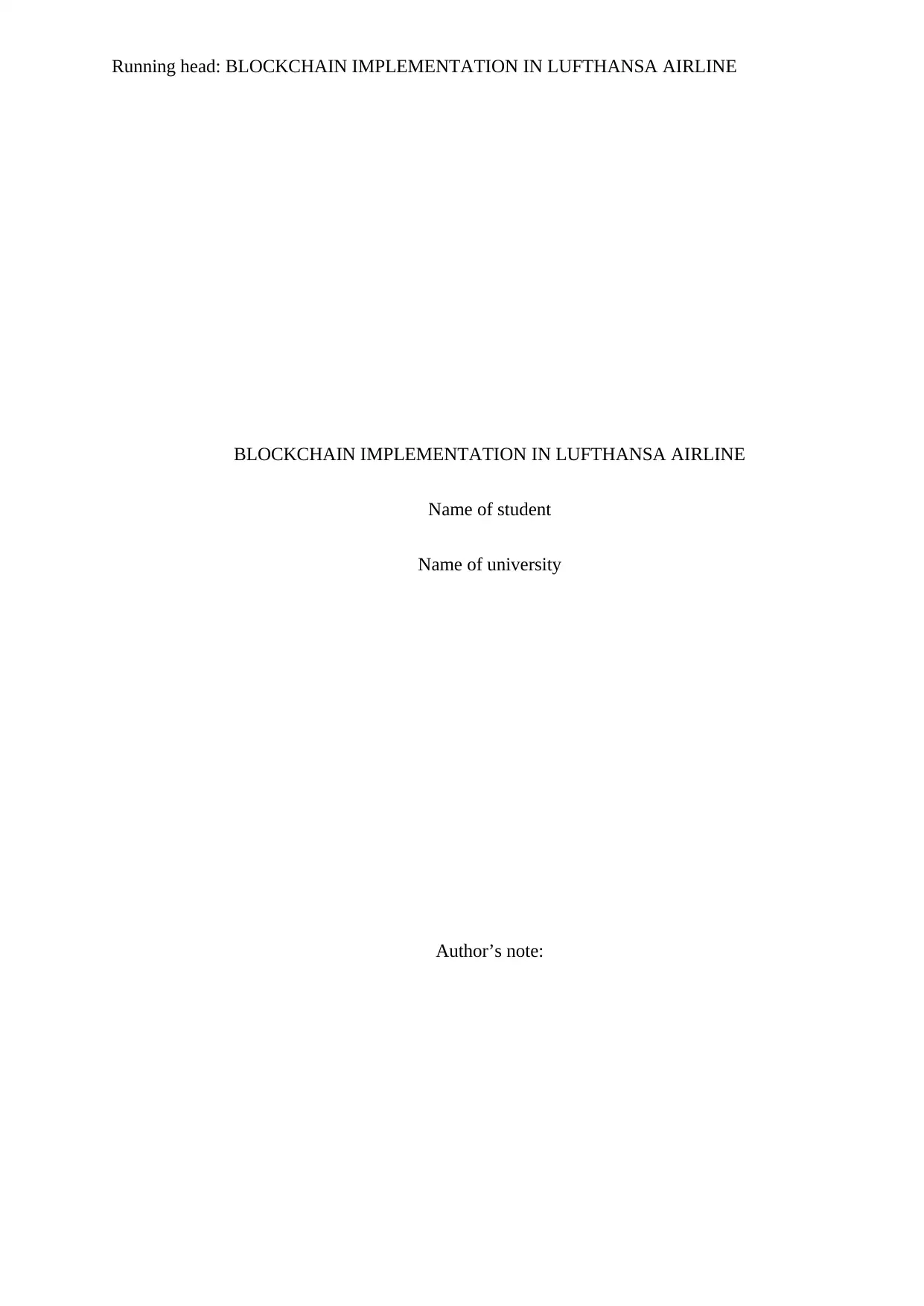
Running head: BLOCKCHAIN IMPLEMENTATION IN LUFTHANSA AIRLINE
BLOCKCHAIN IMPLEMENTATION IN LUFTHANSA AIRLINE
Name of student
Name of university
Author’s note:
BLOCKCHAIN IMPLEMENTATION IN LUFTHANSA AIRLINE
Name of student
Name of university
Author’s note:
Paraphrase This Document
Need a fresh take? Get an instant paraphrase of this document with our AI Paraphraser
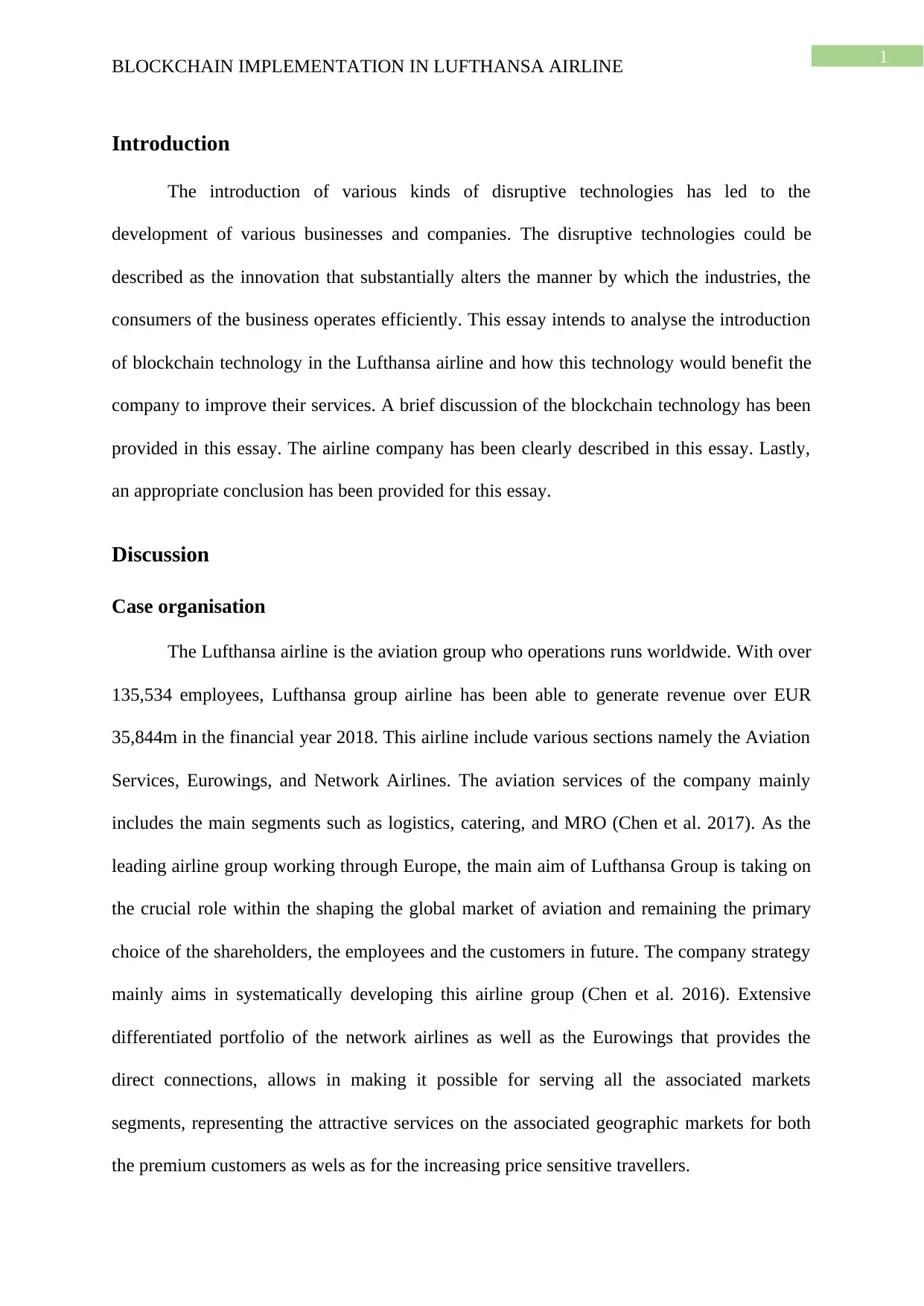
1
BLOCKCHAIN IMPLEMENTATION IN LUFTHANSA AIRLINE
Introduction
The introduction of various kinds of disruptive technologies has led to the
development of various businesses and companies. The disruptive technologies could be
described as the innovation that substantially alters the manner by which the industries, the
consumers of the business operates efficiently. This essay intends to analyse the introduction
of blockchain technology in the Lufthansa airline and how this technology would benefit the
company to improve their services. A brief discussion of the blockchain technology has been
provided in this essay. The airline company has been clearly described in this essay. Lastly,
an appropriate conclusion has been provided for this essay.
Discussion
Case organisation
The Lufthansa airline is the aviation group who operations runs worldwide. With over
135,534 employees, Lufthansa group airline has been able to generate revenue over EUR
35,844m in the financial year 2018. This airline include various sections namely the Aviation
Services, Eurowings, and Network Airlines. The aviation services of the company mainly
includes the main segments such as logistics, catering, and MRO (Chen et al. 2017). As the
leading airline group working through Europe, the main aim of Lufthansa Group is taking on
the crucial role within the shaping the global market of aviation and remaining the primary
choice of the shareholders, the employees and the customers in future. The company strategy
mainly aims in systematically developing this airline group (Chen et al. 2016). Extensive
differentiated portfolio of the network airlines as well as the Eurowings that provides the
direct connections, allows in making it possible for serving all the associated markets
segments, representing the attractive services on the associated geographic markets for both
the premium customers as wels as for the increasing price sensitive travellers.
BLOCKCHAIN IMPLEMENTATION IN LUFTHANSA AIRLINE
Introduction
The introduction of various kinds of disruptive technologies has led to the
development of various businesses and companies. The disruptive technologies could be
described as the innovation that substantially alters the manner by which the industries, the
consumers of the business operates efficiently. This essay intends to analyse the introduction
of blockchain technology in the Lufthansa airline and how this technology would benefit the
company to improve their services. A brief discussion of the blockchain technology has been
provided in this essay. The airline company has been clearly described in this essay. Lastly,
an appropriate conclusion has been provided for this essay.
Discussion
Case organisation
The Lufthansa airline is the aviation group who operations runs worldwide. With over
135,534 employees, Lufthansa group airline has been able to generate revenue over EUR
35,844m in the financial year 2018. This airline include various sections namely the Aviation
Services, Eurowings, and Network Airlines. The aviation services of the company mainly
includes the main segments such as logistics, catering, and MRO (Chen et al. 2017). As the
leading airline group working through Europe, the main aim of Lufthansa Group is taking on
the crucial role within the shaping the global market of aviation and remaining the primary
choice of the shareholders, the employees and the customers in future. The company strategy
mainly aims in systematically developing this airline group (Chen et al. 2016). Extensive
differentiated portfolio of the network airlines as well as the Eurowings that provides the
direct connections, allows in making it possible for serving all the associated markets
segments, representing the attractive services on the associated geographic markets for both
the premium customers as wels as for the increasing price sensitive travellers.
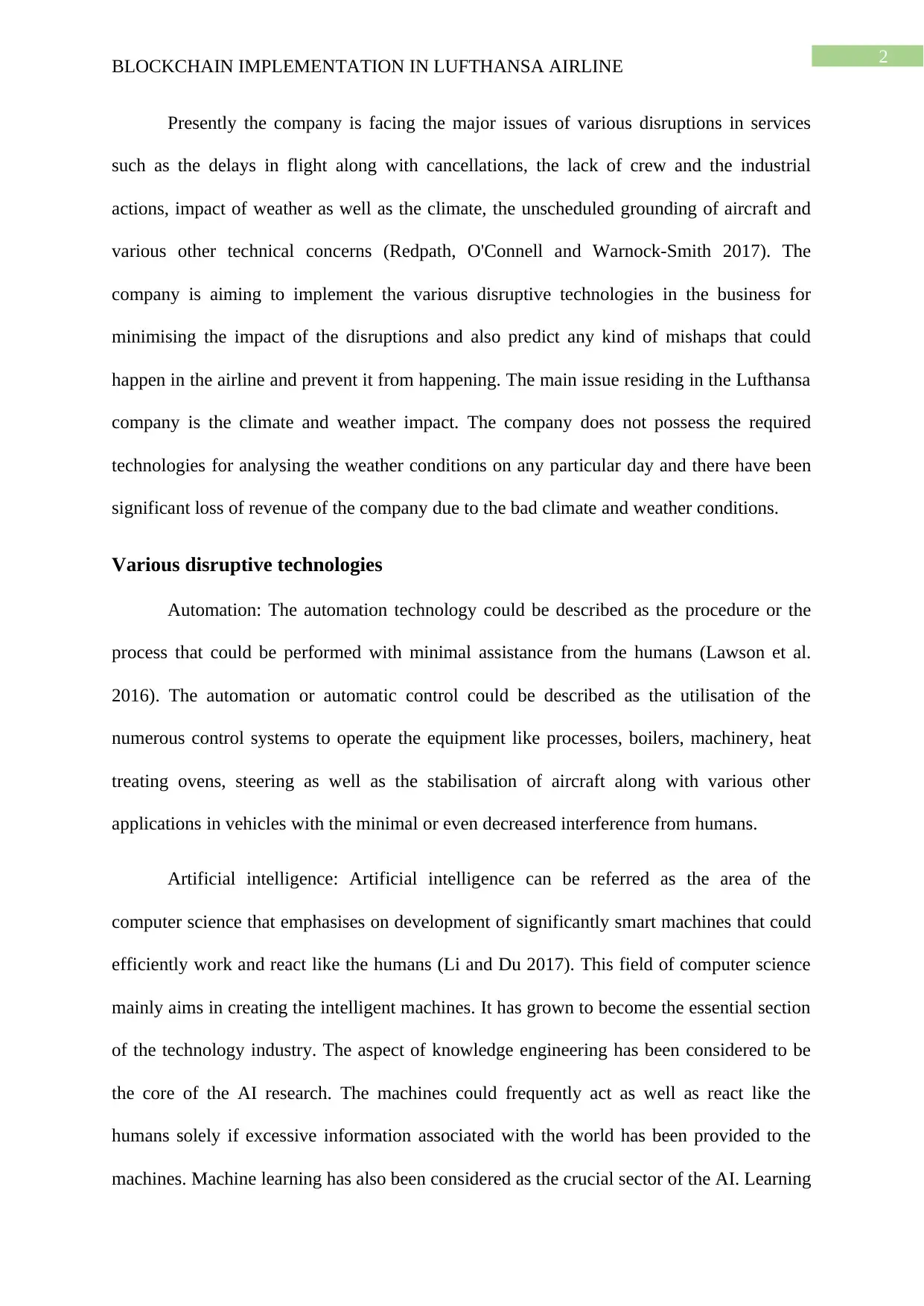
2
BLOCKCHAIN IMPLEMENTATION IN LUFTHANSA AIRLINE
Presently the company is facing the major issues of various disruptions in services
such as the delays in flight along with cancellations, the lack of crew and the industrial
actions, impact of weather as well as the climate, the unscheduled grounding of aircraft and
various other technical concerns (Redpath, O'Connell and Warnock-Smith 2017). The
company is aiming to implement the various disruptive technologies in the business for
minimising the impact of the disruptions and also predict any kind of mishaps that could
happen in the airline and prevent it from happening. The main issue residing in the Lufthansa
company is the climate and weather impact. The company does not possess the required
technologies for analysing the weather conditions on any particular day and there have been
significant loss of revenue of the company due to the bad climate and weather conditions.
Various disruptive technologies
Automation: The automation technology could be described as the procedure or the
process that could be performed with minimal assistance from the humans (Lawson et al.
2016). The automation or automatic control could be described as the utilisation of the
numerous control systems to operate the equipment like processes, boilers, machinery, heat
treating ovens, steering as well as the stabilisation of aircraft along with various other
applications in vehicles with the minimal or even decreased interference from humans.
Artificial intelligence: Artificial intelligence can be referred as the area of the
computer science that emphasises on development of significantly smart machines that could
efficiently work and react like the humans (Li and Du 2017). This field of computer science
mainly aims in creating the intelligent machines. It has grown to become the essential section
of the technology industry. The aspect of knowledge engineering has been considered to be
the core of the AI research. The machines could frequently act as well as react like the
humans solely if excessive information associated with the world has been provided to the
machines. Machine learning has also been considered as the crucial sector of the AI. Learning
BLOCKCHAIN IMPLEMENTATION IN LUFTHANSA AIRLINE
Presently the company is facing the major issues of various disruptions in services
such as the delays in flight along with cancellations, the lack of crew and the industrial
actions, impact of weather as well as the climate, the unscheduled grounding of aircraft and
various other technical concerns (Redpath, O'Connell and Warnock-Smith 2017). The
company is aiming to implement the various disruptive technologies in the business for
minimising the impact of the disruptions and also predict any kind of mishaps that could
happen in the airline and prevent it from happening. The main issue residing in the Lufthansa
company is the climate and weather impact. The company does not possess the required
technologies for analysing the weather conditions on any particular day and there have been
significant loss of revenue of the company due to the bad climate and weather conditions.
Various disruptive technologies
Automation: The automation technology could be described as the procedure or the
process that could be performed with minimal assistance from the humans (Lawson et al.
2016). The automation or automatic control could be described as the utilisation of the
numerous control systems to operate the equipment like processes, boilers, machinery, heat
treating ovens, steering as well as the stabilisation of aircraft along with various other
applications in vehicles with the minimal or even decreased interference from humans.
Artificial intelligence: Artificial intelligence can be referred as the area of the
computer science that emphasises on development of significantly smart machines that could
efficiently work and react like the humans (Li and Du 2017). This field of computer science
mainly aims in creating the intelligent machines. It has grown to become the essential section
of the technology industry. The aspect of knowledge engineering has been considered to be
the core of the AI research. The machines could frequently act as well as react like the
humans solely if excessive information associated with the world has been provided to the
machines. Machine learning has also been considered as the crucial sector of the AI. Learning
⊘ This is a preview!⊘
Do you want full access?
Subscribe today to unlock all pages.

Trusted by 1+ million students worldwide
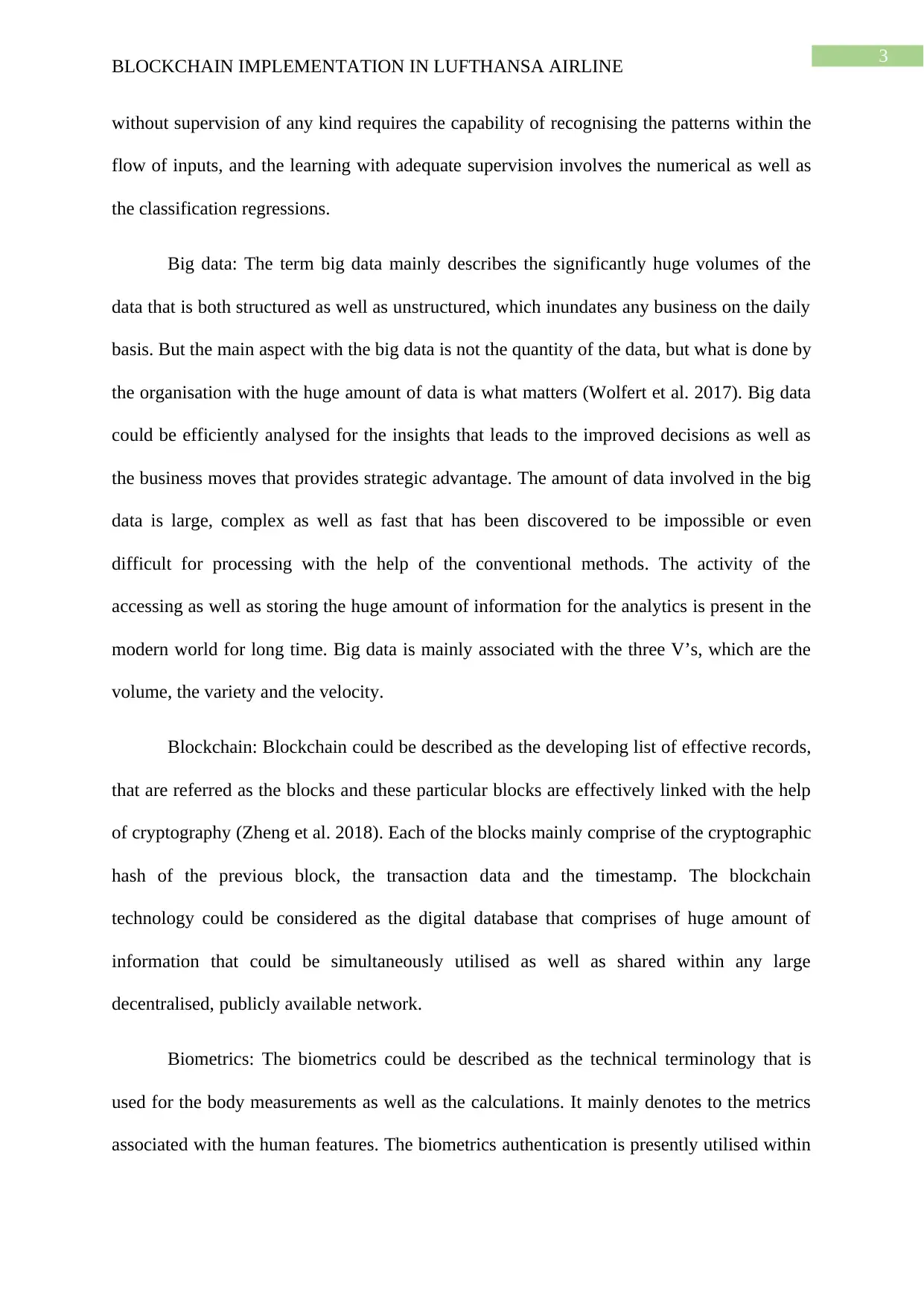
3
BLOCKCHAIN IMPLEMENTATION IN LUFTHANSA AIRLINE
without supervision of any kind requires the capability of recognising the patterns within the
flow of inputs, and the learning with adequate supervision involves the numerical as well as
the classification regressions.
Big data: The term big data mainly describes the significantly huge volumes of the
data that is both structured as well as unstructured, which inundates any business on the daily
basis. But the main aspect with the big data is not the quantity of the data, but what is done by
the organisation with the huge amount of data is what matters (Wolfert et al. 2017). Big data
could be efficiently analysed for the insights that leads to the improved decisions as well as
the business moves that provides strategic advantage. The amount of data involved in the big
data is large, complex as well as fast that has been discovered to be impossible or even
difficult for processing with the help of the conventional methods. The activity of the
accessing as well as storing the huge amount of information for the analytics is present in the
modern world for long time. Big data is mainly associated with the three V’s, which are the
volume, the variety and the velocity.
Blockchain: Blockchain could be described as the developing list of effective records,
that are referred as the blocks and these particular blocks are effectively linked with the help
of cryptography (Zheng et al. 2018). Each of the blocks mainly comprise of the cryptographic
hash of the previous block, the transaction data and the timestamp. The blockchain
technology could be considered as the digital database that comprises of huge amount of
information that could be simultaneously utilised as well as shared within any large
decentralised, publicly available network.
Biometrics: The biometrics could be described as the technical terminology that is
used for the body measurements as well as the calculations. It mainly denotes to the metrics
associated with the human features. The biometrics authentication is presently utilised within
BLOCKCHAIN IMPLEMENTATION IN LUFTHANSA AIRLINE
without supervision of any kind requires the capability of recognising the patterns within the
flow of inputs, and the learning with adequate supervision involves the numerical as well as
the classification regressions.
Big data: The term big data mainly describes the significantly huge volumes of the
data that is both structured as well as unstructured, which inundates any business on the daily
basis. But the main aspect with the big data is not the quantity of the data, but what is done by
the organisation with the huge amount of data is what matters (Wolfert et al. 2017). Big data
could be efficiently analysed for the insights that leads to the improved decisions as well as
the business moves that provides strategic advantage. The amount of data involved in the big
data is large, complex as well as fast that has been discovered to be impossible or even
difficult for processing with the help of the conventional methods. The activity of the
accessing as well as storing the huge amount of information for the analytics is present in the
modern world for long time. Big data is mainly associated with the three V’s, which are the
volume, the variety and the velocity.
Blockchain: Blockchain could be described as the developing list of effective records,
that are referred as the blocks and these particular blocks are effectively linked with the help
of cryptography (Zheng et al. 2018). Each of the blocks mainly comprise of the cryptographic
hash of the previous block, the transaction data and the timestamp. The blockchain
technology could be considered as the digital database that comprises of huge amount of
information that could be simultaneously utilised as well as shared within any large
decentralised, publicly available network.
Biometrics: The biometrics could be described as the technical terminology that is
used for the body measurements as well as the calculations. It mainly denotes to the metrics
associated with the human features. The biometrics authentication is presently utilised within
Paraphrase This Document
Need a fresh take? Get an instant paraphrase of this document with our AI Paraphraser
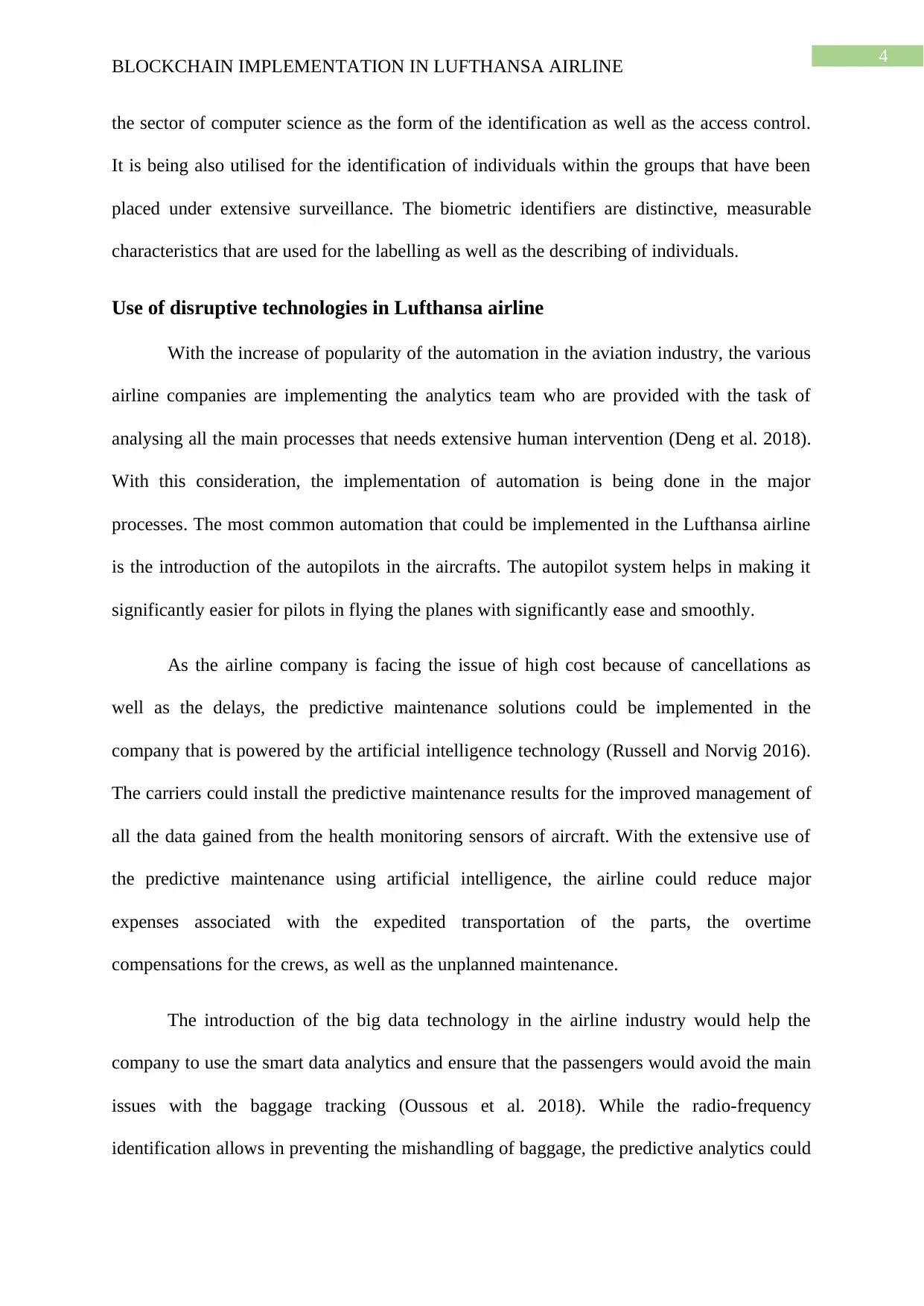
4
BLOCKCHAIN IMPLEMENTATION IN LUFTHANSA AIRLINE
the sector of computer science as the form of the identification as well as the access control.
It is being also utilised for the identification of individuals within the groups that have been
placed under extensive surveillance. The biometric identifiers are distinctive, measurable
characteristics that are used for the labelling as well as the describing of individuals.
Use of disruptive technologies in Lufthansa airline
With the increase of popularity of the automation in the aviation industry, the various
airline companies are implementing the analytics team who are provided with the task of
analysing all the main processes that needs extensive human intervention (Deng et al. 2018).
With this consideration, the implementation of automation is being done in the major
processes. The most common automation that could be implemented in the Lufthansa airline
is the introduction of the autopilots in the aircrafts. The autopilot system helps in making it
significantly easier for pilots in flying the planes with significantly ease and smoothly.
As the airline company is facing the issue of high cost because of cancellations as
well as the delays, the predictive maintenance solutions could be implemented in the
company that is powered by the artificial intelligence technology (Russell and Norvig 2016).
The carriers could install the predictive maintenance results for the improved management of
all the data gained from the health monitoring sensors of aircraft. With the extensive use of
the predictive maintenance using artificial intelligence, the airline could reduce major
expenses associated with the expedited transportation of the parts, the overtime
compensations for the crews, as well as the unplanned maintenance.
The introduction of the big data technology in the airline industry would help the
company to use the smart data analytics and ensure that the passengers would avoid the main
issues with the baggage tracking (Oussous et al. 2018). While the radio-frequency
identification allows in preventing the mishandling of baggage, the predictive analytics could
BLOCKCHAIN IMPLEMENTATION IN LUFTHANSA AIRLINE
the sector of computer science as the form of the identification as well as the access control.
It is being also utilised for the identification of individuals within the groups that have been
placed under extensive surveillance. The biometric identifiers are distinctive, measurable
characteristics that are used for the labelling as well as the describing of individuals.
Use of disruptive technologies in Lufthansa airline
With the increase of popularity of the automation in the aviation industry, the various
airline companies are implementing the analytics team who are provided with the task of
analysing all the main processes that needs extensive human intervention (Deng et al. 2018).
With this consideration, the implementation of automation is being done in the major
processes. The most common automation that could be implemented in the Lufthansa airline
is the introduction of the autopilots in the aircrafts. The autopilot system helps in making it
significantly easier for pilots in flying the planes with significantly ease and smoothly.
As the airline company is facing the issue of high cost because of cancellations as
well as the delays, the predictive maintenance solutions could be implemented in the
company that is powered by the artificial intelligence technology (Russell and Norvig 2016).
The carriers could install the predictive maintenance results for the improved management of
all the data gained from the health monitoring sensors of aircraft. With the extensive use of
the predictive maintenance using artificial intelligence, the airline could reduce major
expenses associated with the expedited transportation of the parts, the overtime
compensations for the crews, as well as the unplanned maintenance.
The introduction of the big data technology in the airline industry would help the
company to use the smart data analytics and ensure that the passengers would avoid the main
issues with the baggage tracking (Oussous et al. 2018). While the radio-frequency
identification allows in preventing the mishandling of baggage, the predictive analytics could
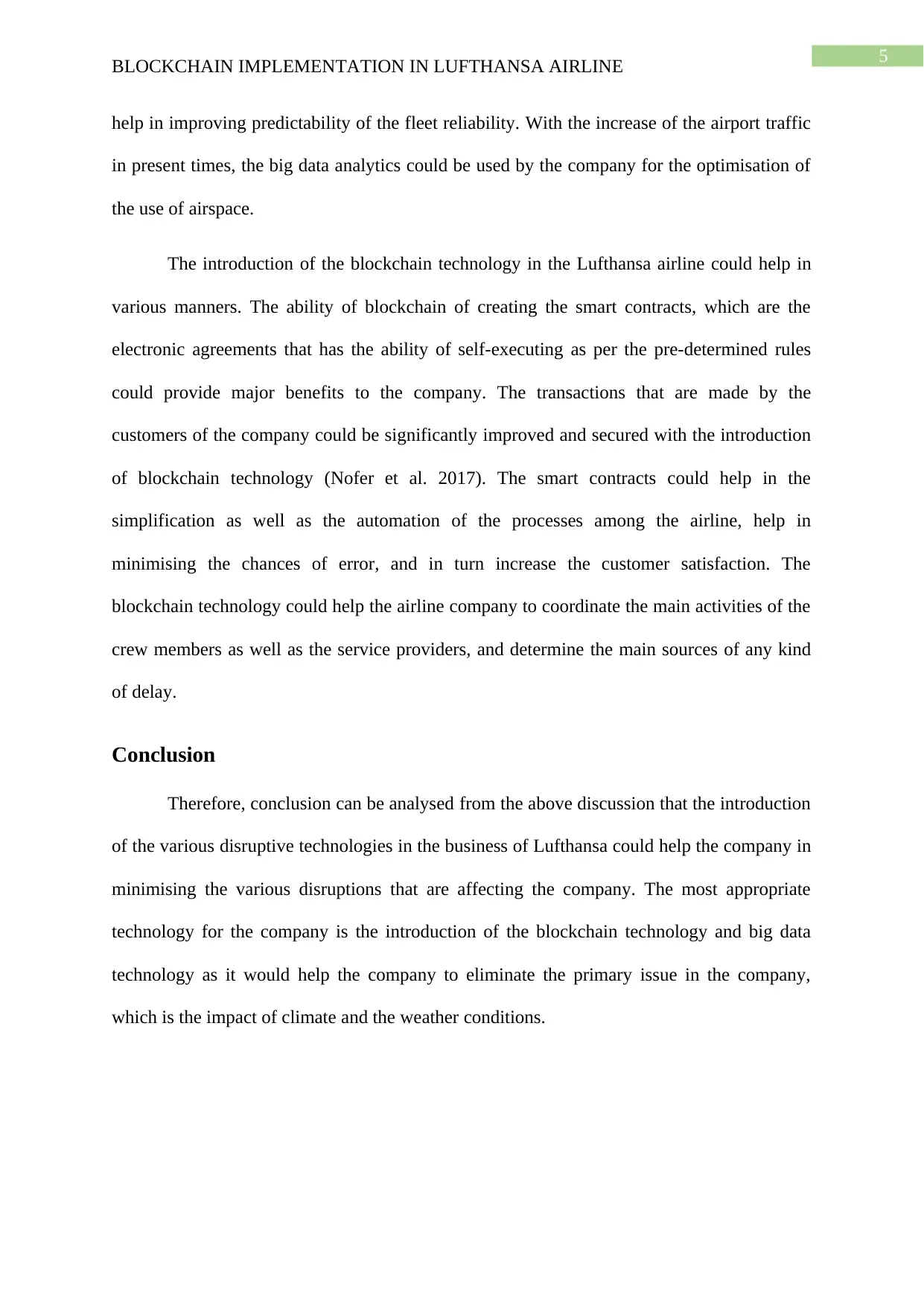
5
BLOCKCHAIN IMPLEMENTATION IN LUFTHANSA AIRLINE
help in improving predictability of the fleet reliability. With the increase of the airport traffic
in present times, the big data analytics could be used by the company for the optimisation of
the use of airspace.
The introduction of the blockchain technology in the Lufthansa airline could help in
various manners. The ability of blockchain of creating the smart contracts, which are the
electronic agreements that has the ability of self-executing as per the pre-determined rules
could provide major benefits to the company. The transactions that are made by the
customers of the company could be significantly improved and secured with the introduction
of blockchain technology (Nofer et al. 2017). The smart contracts could help in the
simplification as well as the automation of the processes among the airline, help in
minimising the chances of error, and in turn increase the customer satisfaction. The
blockchain technology could help the airline company to coordinate the main activities of the
crew members as well as the service providers, and determine the main sources of any kind
of delay.
Conclusion
Therefore, conclusion can be analysed from the above discussion that the introduction
of the various disruptive technologies in the business of Lufthansa could help the company in
minimising the various disruptions that are affecting the company. The most appropriate
technology for the company is the introduction of the blockchain technology and big data
technology as it would help the company to eliminate the primary issue in the company,
which is the impact of climate and the weather conditions.
BLOCKCHAIN IMPLEMENTATION IN LUFTHANSA AIRLINE
help in improving predictability of the fleet reliability. With the increase of the airport traffic
in present times, the big data analytics could be used by the company for the optimisation of
the use of airspace.
The introduction of the blockchain technology in the Lufthansa airline could help in
various manners. The ability of blockchain of creating the smart contracts, which are the
electronic agreements that has the ability of self-executing as per the pre-determined rules
could provide major benefits to the company. The transactions that are made by the
customers of the company could be significantly improved and secured with the introduction
of blockchain technology (Nofer et al. 2017). The smart contracts could help in the
simplification as well as the automation of the processes among the airline, help in
minimising the chances of error, and in turn increase the customer satisfaction. The
blockchain technology could help the airline company to coordinate the main activities of the
crew members as well as the service providers, and determine the main sources of any kind
of delay.
Conclusion
Therefore, conclusion can be analysed from the above discussion that the introduction
of the various disruptive technologies in the business of Lufthansa could help the company in
minimising the various disruptions that are affecting the company. The most appropriate
technology for the company is the introduction of the blockchain technology and big data
technology as it would help the company to eliminate the primary issue in the company,
which is the impact of climate and the weather conditions.
⊘ This is a preview!⊘
Do you want full access?
Subscribe today to unlock all pages.

Trusted by 1+ million students worldwide
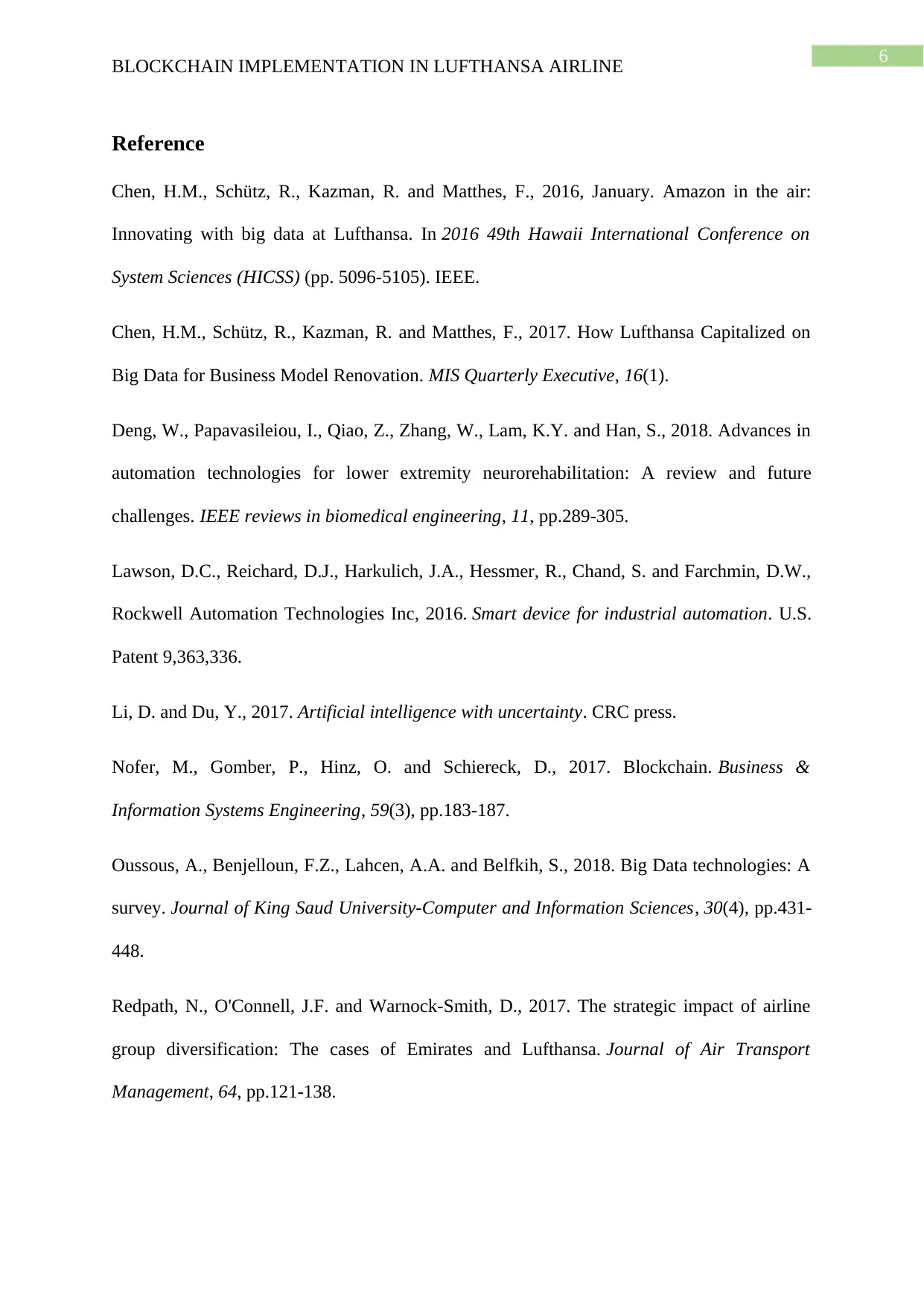
6
BLOCKCHAIN IMPLEMENTATION IN LUFTHANSA AIRLINE
Reference
Chen, H.M., Schütz, R., Kazman, R. and Matthes, F., 2016, January. Amazon in the air:
Innovating with big data at Lufthansa. In 2016 49th Hawaii International Conference on
System Sciences (HICSS) (pp. 5096-5105). IEEE.
Chen, H.M., Schütz, R., Kazman, R. and Matthes, F., 2017. How Lufthansa Capitalized on
Big Data for Business Model Renovation. MIS Quarterly Executive, 16(1).
Deng, W., Papavasileiou, I., Qiao, Z., Zhang, W., Lam, K.Y. and Han, S., 2018. Advances in
automation technologies for lower extremity neurorehabilitation: A review and future
challenges. IEEE reviews in biomedical engineering, 11, pp.289-305.
Lawson, D.C., Reichard, D.J., Harkulich, J.A., Hessmer, R., Chand, S. and Farchmin, D.W.,
Rockwell Automation Technologies Inc, 2016. Smart device for industrial automation. U.S.
Patent 9,363,336.
Li, D. and Du, Y., 2017. Artificial intelligence with uncertainty. CRC press.
Nofer, M., Gomber, P., Hinz, O. and Schiereck, D., 2017. Blockchain. Business &
Information Systems Engineering, 59(3), pp.183-187.
Oussous, A., Benjelloun, F.Z., Lahcen, A.A. and Belfkih, S., 2018. Big Data technologies: A
survey. Journal of King Saud University-Computer and Information Sciences, 30(4), pp.431-
448.
Redpath, N., O'Connell, J.F. and Warnock-Smith, D., 2017. The strategic impact of airline
group diversification: The cases of Emirates and Lufthansa. Journal of Air Transport
Management, 64, pp.121-138.
BLOCKCHAIN IMPLEMENTATION IN LUFTHANSA AIRLINE
Reference
Chen, H.M., Schütz, R., Kazman, R. and Matthes, F., 2016, January. Amazon in the air:
Innovating with big data at Lufthansa. In 2016 49th Hawaii International Conference on
System Sciences (HICSS) (pp. 5096-5105). IEEE.
Chen, H.M., Schütz, R., Kazman, R. and Matthes, F., 2017. How Lufthansa Capitalized on
Big Data for Business Model Renovation. MIS Quarterly Executive, 16(1).
Deng, W., Papavasileiou, I., Qiao, Z., Zhang, W., Lam, K.Y. and Han, S., 2018. Advances in
automation technologies for lower extremity neurorehabilitation: A review and future
challenges. IEEE reviews in biomedical engineering, 11, pp.289-305.
Lawson, D.C., Reichard, D.J., Harkulich, J.A., Hessmer, R., Chand, S. and Farchmin, D.W.,
Rockwell Automation Technologies Inc, 2016. Smart device for industrial automation. U.S.
Patent 9,363,336.
Li, D. and Du, Y., 2017. Artificial intelligence with uncertainty. CRC press.
Nofer, M., Gomber, P., Hinz, O. and Schiereck, D., 2017. Blockchain. Business &
Information Systems Engineering, 59(3), pp.183-187.
Oussous, A., Benjelloun, F.Z., Lahcen, A.A. and Belfkih, S., 2018. Big Data technologies: A
survey. Journal of King Saud University-Computer and Information Sciences, 30(4), pp.431-
448.
Redpath, N., O'Connell, J.F. and Warnock-Smith, D., 2017. The strategic impact of airline
group diversification: The cases of Emirates and Lufthansa. Journal of Air Transport
Management, 64, pp.121-138.
Paraphrase This Document
Need a fresh take? Get an instant paraphrase of this document with our AI Paraphraser

7
BLOCKCHAIN IMPLEMENTATION IN LUFTHANSA AIRLINE
Russell, S.J. and Norvig, P., 2016. Artificial intelligence: a modern approach. Malaysia;
Pearson Education Limited,.
Wolfert, S., Ge, L., Verdouw, C. and Bogaardt, M.J., 2017. Big data in smart farming–a
review. Agricultural Systems, 153, pp.69-80.
Zheng, Z., Xie, S., Dai, H.N., Chen, X. and Wang, H., 2018. Blockchain challenges and
opportunities: A survey. International Journal of Web and Grid Services, 14(4), pp.352-375.
BLOCKCHAIN IMPLEMENTATION IN LUFTHANSA AIRLINE
Russell, S.J. and Norvig, P., 2016. Artificial intelligence: a modern approach. Malaysia;
Pearson Education Limited,.
Wolfert, S., Ge, L., Verdouw, C. and Bogaardt, M.J., 2017. Big data in smart farming–a
review. Agricultural Systems, 153, pp.69-80.
Zheng, Z., Xie, S., Dai, H.N., Chen, X. and Wang, H., 2018. Blockchain challenges and
opportunities: A survey. International Journal of Web and Grid Services, 14(4), pp.352-375.
1 out of 8
Related Documents
Your All-in-One AI-Powered Toolkit for Academic Success.
+13062052269
info@desklib.com
Available 24*7 on WhatsApp / Email
![[object Object]](/_next/static/media/star-bottom.7253800d.svg)
Unlock your academic potential
Copyright © 2020–2025 A2Z Services. All Rights Reserved. Developed and managed by ZUCOL.





